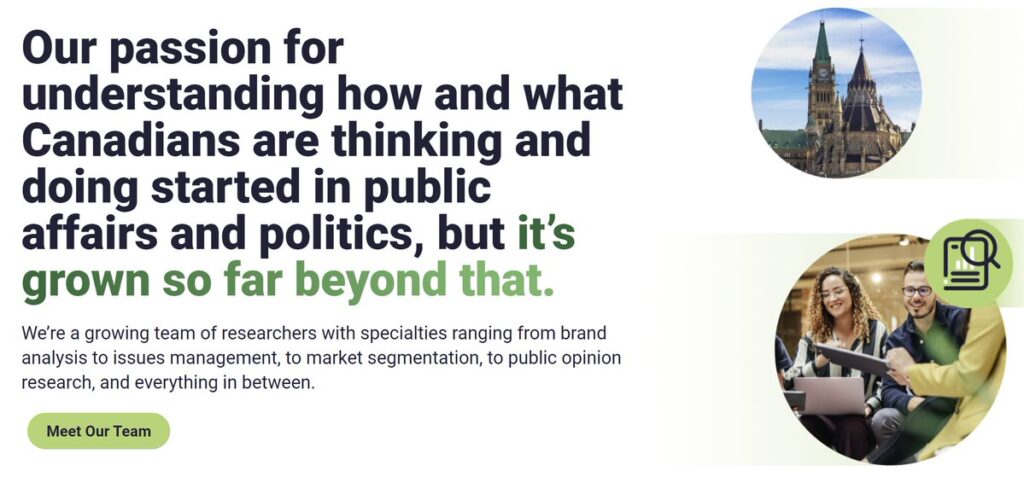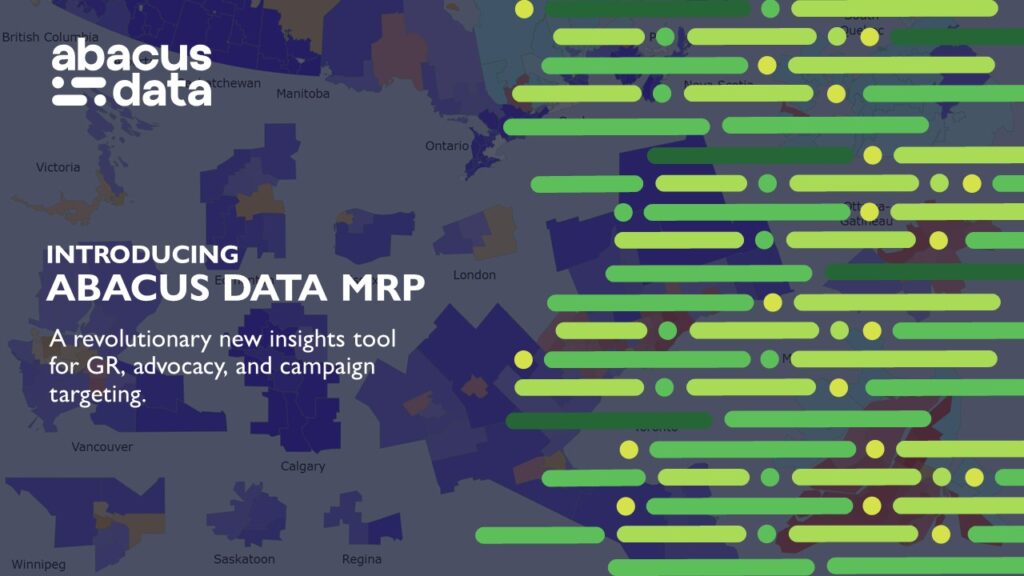Disadvantage Conservative: What advanced modelling tells us about why the Conservatives are trailing the Liberals.
Two weeks out from election day, the story many expected to be writing by now—about Pierre Poilievre’s march to victory—hasn’t materialized. Despite years of strong polling, a Prime Minister with record-low approval, and a party machine firing on all cylinders, the Conservative Party now finds itself trailing the Liberals in every major publicly released poll, including ours, where the gap is now at four points.
So what happened?
To understand why Poilievre is falling short, we used a binary logistic regression model to dig beneath surface-level polling. Unlike a simple crosstab or approval rating, a logistic regression model allows us to pinpoint which factors actually predict someone’s likelihood of voting Conservative. It answers the question: if we know someone’s views on certain issues or leaders, how much does that increase or decrease the chance they’ll choose the Conservative Party on election day?
This method gives us a clear look at which levers Poilievre has successfully pulled—and which remain stuck.
A Party Built Around a Person
The first and most powerful predictor of a Conservative vote is a positive impression of Pierre Poilievre. When voters like him, they’re likely to support the party. That sounds obvious, but it’s more consequential than it seems. In a political landscape increasingly driven by leader brands rather than party brands, Poilievre is the Conservative message. He’s not just the face of the campaign—he is the campaign.
And the data shows that for many, that works. Poilievre is seen by a significant portion of voters as best suited to manage the economy, deal with tough international actors like Donald Trump, and—perhaps most importantly—keep Canada united. Those are powerful signals of competence and strength. Among those who see him that way, support for the Conservatives is solid.
But that’s also the trap.
Strength Without Scale
Poilievre’s support base is motivated, aligned, and deeply loyal. But it’s not expanding. That’s because the coalition he has built doesn’t yet reach far enough into the electorate’s middle—the soft voters still up for grabs, the ones who will decide this election.
The data makes this clear. While Poilievre scores well on economic credibility and leadership toughness, those signals aren’t being reinforced by a broader sense of relatability or optimism. Voters aren’t rejecting him in huge numbers, but many remain unconvinced he’s for them. They don’t dislike the pitch—they just don’t see it as theirs.
In fact, several of the variables we tested—like whether voters think Poilievre is best at reducing the cost of living or fixing housing—didn’t significantly predict Conservative support once we accounted for other factors. This suggests that voters may agree with Poilievre on the problems, but they’re not yet sold that he’s the one who can deliver. Think about that – whether or not you think Poilievre is best at reducing the cost of living is not a predictor of support for the Conservatives. That just reinforces how much the focus of this campaign changed and the Conservative Party’s inability to make it about affordability or change.
The Desire for Change Is Not High or Wide Enough
Speaking about change, the 2025 campaign was supposed to be all about it. After a decade of Liberal government, a stagnant standard of living, and growing affordability anxiety, the Conservatives banked on a public thirst for something new. And for many voters, that thirst exists.
But not for everyone. In fact, one of the strongest negative predictors of a Conservative vote in our model is a lack of urgency for change. If a voter doesn’t believe it’s definitely time for a new government, they are much less likely to choose the Conservatives.
And here’s where it gets interesting: enough voters still feel that things aren’t that bad, or that Carney represents a different kind of Liberal leadership, that they’re willing to give the party another chance. The public’s desire for change exists—but it’s no longer deep or broad enough to create a wave. And without that wave, Poilievre’s path to a majority government.
What Doesn’t Move the Dial
One of the striking findings from the model is how little traditional demographic variables matter right now. Gender, age, a sense of precarity, and even university education don’t significantly predict Conservative support. This suggests that Poilievre’s coalition isn’t being driven by identity politics or deep economic divides. Instead, it’s shaped by beliefs—especially about leadership, competence, and the need for change.
It’s Not You, It’s Me.
It’s also worth noting that a negative impression of Mark Carney doesn’t significantly increase Conservative support. This is not shaping up to be a “stop the Liberals” campaign the way 2011 was about stopping the NDP or 2019 may have been partly about stopping Trudeau. The Conservative vote right now is affirmatively pro-Poilievre—but it’s not yet compelling enough for those who remain unsure.
So What Does This All Mean?
With two weeks left, the Conservatives are facing a paradox. They have the most unified base, the clearest message on affordable, and a leader whose brand is resonating with a big slice of the electorate. But they haven’t built a coalition wide enough to win.
To change that, the party will need to do more than hammer the Liberals or repeat its “common sense” mantra. It will need to reach voters who agree with Poilievre on the problems but doubt he understands them personally or has the competence or experience to solve them – relative to Mark Carney. The data suggests these voters are movable—but only with the right appeal.
That might mean softening the message, highlighting compassion as much as strength, and showing that the party has a plan for people’s lives, not just the balance sheet. It could mean showing a more human, less combative side of the Conservative leader—especially in battleground ridings where the race is tightest. It’s debate week – if not this week – when?
Poilievre doesn’t need to abandon his base to win. But he does need to grow it. And the clock is ticking.
The data tells us the story: the Poilievre brand is working—but only for some. To win, he needs more than confidence. He needs connection.
The Model at Work
Here’s how the model plays out in practice, using five different voter profiles to show how different combinations of beliefs affect the probability of voting Conservative.
The most likely Conservative voter, unsurprisingly, is someone who holds all the right perceptions: they like Poilievre, dislike Carney, think Poilievre is best on both the economy and Trump, and firmly believe it’s time for a change. For this ideal scenario, the probability of voting Conservative hits 96%. But remove just one variable—the belief that it’s definitely time for a change—and the probability drops to 86%. That 10-point swing underscores how critical the “change” narrative is to the Conservative campaign’s success. Without that motivation, even Poilievre’s personal brand and economic message can’t fully close the deal.
Things shift even more when we test more limited belief sets. If a voter believes Poilievre is best on the economy, but doesn’t like him personally, doesn’t dislike Carney, and isn’t aligned on other leadership traits, the probability drops to 58%. That’s still a decent chance, but it’s clear the economic argument alone isn’t sufficient to drive the vote—it needs to be paired with a deeper personal or emotional connection.
Perhaps most instructive is what happens when someone has a positive view of Poilievre but doesn’t think it’s time for a change. In that case, the odds of voting Conservative drop to just 24%. And among those who hold none of the key perceptions—no positive view of Poilievre, no preference for him on Trump or the economy, and no sense of urgency for change—the probability of voting Conservative plummets to 8%. These scenarios reveal the limits of the Conservative coalition and reinforce a central insight from the model: Poilievre’s support is strong, but not yet broad. Without a deeper sense of urgency for change across the electorate, the party will struggle to build the winning coalition it needs.
Methodology
The survey was conducted with 1,900 adult Canadians over the age of 18 from April 3 to 8, 2025. A random sample of panelists were invited to complete the survey from a set of partner panels based on the Lucid exchange platform. These partners are typically double opt-in survey panels, blended to manage out potential skews in the data from a single source.
The margin of error for a comparable probability-based random sample of the same size is +/- 2.1%, 19 times out of 20.
The data were weighted according to census data to ensure that the sample matched Canada’s population according to age, gender, educational attainment, and region. Totals may not add up to 100 due to rounding.
This survey was paid for by Abacus Data Inc.
Abacus Data follows the CRIC Public Opinion Research Standards and Disclosure Requirements that can be found here: https://canadianresearchinsightscouncil.ca/standards/
Binary Logistic Regression
To identify the key predictors of support for the Liberal Party under Mark Carney’s leadership, we used a binary logistic regression model. This statistical technique estimates the likelihood that a respondent chooses a particular outcome—in this case, voting Liberal—based on a set of independent variables.
Unlike linear regression, which predicts a continuous outcome, logistic regression is used when the dependent variable is binary (e.g., support vs. no support). The model calculates the probability that an individual will vote Liberal, based on factors such as personal impressions of the leaders, issue priorities, demographic characteristics, and views on the state of the country.
The coefficients from the model represent the change in the log-odds of voting Liberal associated with each predictor, holding all other variables constant. A positive coefficient indicates an increased likelihood of voting Liberal, while a negative coefficient suggests a decreased likelihood.
This method allows us to isolate the individual impact of each factor and identify which attributes are most strongly associated with support for the Liberals—offering a more precise understanding of what’s driving voter behaviour in the current election context.
While traditional R-squared (as used in linear regression) doesn’t directly apply to logistic regression, we use pseudo R-squared measures to assess model fit.
- Nagelkerke’s R-squared (0.7078) is an adjusted version of the Cox & Snell R-squared, scaled to range between 0 and 1. It suggests that the model explains approximately 71% of the variation in vote intention—indicating strong explanatory power for a social science model.
- McFadden’s rho-squared (0.7001) is another commonly used pseudo R-squared that compares the fit of the full model against a null (intercept-only) model. Values above 0.4 are typically considered indicative of a very good model fit.
Both values suggest this logistic model provides a robust and meaningful explanation for what drives someone to vote Liberal in this election scenario.
ABOUT ABACUS DATA
We are Canada’s most sought-after, influential, and impactful polling and market research firm. We are hired by many of North America’s most respected and influential brands and organizations.
We use the latest technology, sound science, and deep experience to generate top-flight research-based advice to our clients. We offer global research capacity with a strong focus on customer service, attention to detail, and exceptional value.
And we are growing throughout all parts of Canada and the United States and have capacity for new clients who want high quality research insights with enlightened hospitality.
Our record speaks for itself: we were one of the most accurate pollsters conducting research during the 2021 Canadian election following up on our outstanding record in the 2019, 2015, and 2011 federal elections.
Contact us with any questions.
Find out more about how we can help your organization by downloading our corporate profile and service offering.

























































